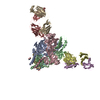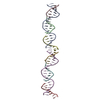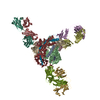[English] 日本語
 Yorodumi
Yorodumi- PDB-7mpg: Cryo-EM structure of Prefusion-stabilized RSV F (DS-Cav1) in comp... -
+ Open data
Open data
- Basic information
Basic information
| Entry | Database: PDB / ID: 7mpg | ||||||
|---|---|---|---|---|---|---|---|
| Title | Cryo-EM structure of Prefusion-stabilized RSV F (DS-Cav1) in complex with Fab AM14 | ||||||
 Components Components |
| ||||||
 Keywords Keywords | IMMUNE SYSTEM / antigen / antibody / epitope / vaccine / structural vaccinology | ||||||
| Function / homology |  Function and homology information Function and homology informationsymbiont-mediated induction of syncytium formation / host cell Golgi membrane / entry receptor-mediated virion attachment to host cell / fusion of virus membrane with host plasma membrane / viral envelope / symbiont entry into host cell / host cell plasma membrane / virion membrane / membrane Similarity search - Function | ||||||
| Biological species |  Human respiratory syncytial virus Human respiratory syncytial virus  Human immunodeficiency virus 1 Human immunodeficiency virus 1 Homo sapiens (human) Homo sapiens (human) | ||||||
| Method | ELECTRON MICROSCOPY / single particle reconstruction / cryo EM / Resolution: 3.4 Å | ||||||
 Authors Authors | Abeyrathne, P.D. / Malito, E. / Harshbarger, W.D. | ||||||
 Citation Citation |  Journal: MAbs / Year: 2021 Journal: MAbs / Year: 2021Title: Improved epitope resolution of the prefusion trimer-specific antibody AM14 bound to the RSV F glycoprotein. Authors: Wayne Harshbarger / Priyanka D Abeyrathne / Sai Tian / Ying Huang / Sumana Chandramouli / Matthew James Bottomley / Enrico Malito /  Abstract: Respiratory syncytial virus (RSV) is the most common cause of acute lower respiratory tract infections resulting in medical intervention and hospitalizations during infancy and early childhood, and ...Respiratory syncytial virus (RSV) is the most common cause of acute lower respiratory tract infections resulting in medical intervention and hospitalizations during infancy and early childhood, and vaccination against RSV remains a public health priority. The RSV F glycoprotein is a major target of neutralizing antibodies, and the prefusion stabilized form of F (DS-Cav1) is under investigation as a vaccine antigen. AM14 is a human monoclonal antibody with the exclusive capacity of binding an epitope on prefusion F (PreF), which spans two F protomers. The quality of recognizing a trimer-specific epitope makes AM14 valuable for probing PreF-based immunogen conformation and functionality during vaccine production. Currently, only a low-resolution (5.5 Å) X-ray structure is available of the PreF-AM14 complex, revealing few reliable details of the interface. Here, we perform complementary structural studies using X-ray crystallography and cryo-electron microscopy (cryo-EM) to provide improved resolution structures at 3.6 Å and 3.4 Å resolutions, respectively. Both X-ray and cryo-EM structures provide clear side-chain densities, which allow for accurate mapping of the AM14 epitope on DS-Cav1. The structures help rationalize the molecular basis for AM14 loss of binding to RSV F monoclonal antibody-resistant mutants and reveal flexibility for the side chain of a key antigenic residue on PreF. This work provides the basis for a comprehensive understanding of RSV F trimer specificity with implications in vaccine design and quality assessment of PreF-based immunogens. | ||||||
| History |
|
- Structure visualization
Structure visualization
| Movie |
 Movie viewer Movie viewer |
|---|---|
| Structure viewer | Molecule:  Molmil Molmil Jmol/JSmol Jmol/JSmol |
- Downloads & links
Downloads & links
- Download
Download
| PDBx/mmCIF format |  7mpg.cif.gz 7mpg.cif.gz | 452.2 KB | Display |  PDBx/mmCIF format PDBx/mmCIF format |
|---|---|---|---|---|
| PDB format |  pdb7mpg.ent.gz pdb7mpg.ent.gz | 368.9 KB | Display |  PDB format PDB format |
| PDBx/mmJSON format |  7mpg.json.gz 7mpg.json.gz | Tree view |  PDBx/mmJSON format PDBx/mmJSON format | |
| Others |  Other downloads Other downloads |
-Validation report
| Summary document |  7mpg_validation.pdf.gz 7mpg_validation.pdf.gz | 1008.1 KB | Display |  wwPDB validaton report wwPDB validaton report |
|---|---|---|---|---|
| Full document |  7mpg_full_validation.pdf.gz 7mpg_full_validation.pdf.gz | 1 MB | Display | |
| Data in XML |  7mpg_validation.xml.gz 7mpg_validation.xml.gz | 77.5 KB | Display | |
| Data in CIF |  7mpg_validation.cif.gz 7mpg_validation.cif.gz | 115 KB | Display | |
| Arichive directory |  https://data.pdbj.org/pub/pdb/validation_reports/mp/7mpg https://data.pdbj.org/pub/pdb/validation_reports/mp/7mpg ftp://data.pdbj.org/pub/pdb/validation_reports/mp/7mpg ftp://data.pdbj.org/pub/pdb/validation_reports/mp/7mpg | HTTPS FTP |
-Related structure data
| Related structure data |  23933MC  7mmnC M: map data used to model this data C: citing same article ( |
|---|---|
| Similar structure data |
- Links
Links
- Assembly
Assembly
| Deposited unit | 
| ||||||||||||||||||||||||||||||||||||||||||||||||||||||||||||||||||||||||||||||||||||||||||||||
|---|---|---|---|---|---|---|---|---|---|---|---|---|---|---|---|---|---|---|---|---|---|---|---|---|---|---|---|---|---|---|---|---|---|---|---|---|---|---|---|---|---|---|---|---|---|---|---|---|---|---|---|---|---|---|---|---|---|---|---|---|---|---|---|---|---|---|---|---|---|---|---|---|---|---|---|---|---|---|---|---|---|---|---|---|---|---|---|---|---|---|---|---|---|---|---|
| 1 |
| ||||||||||||||||||||||||||||||||||||||||||||||||||||||||||||||||||||||||||||||||||||||||||||||
| Noncrystallographic symmetry (NCS) | NCS domain:
NCS domain segments:
NCS ensembles :
|
- Components
Components
| #1: Protein | Mass: 54806.496 Da / Num. of mol.: 3 / Mutation: S155C,S190F,V207L,S290C Source method: isolated from a genetically manipulated source Source: (gene. exp.)  Human respiratory syncytial virus, (gene. exp.) Human respiratory syncytial virus, (gene. exp.)   Human immunodeficiency virus 1 Human immunodeficiency virus 1Gene: RSV F / Production host:  #2: Antibody | Mass: 26380.352 Da / Num. of mol.: 3 Source method: isolated from a genetically manipulated source Source: (gene. exp.)  Homo sapiens (human) / Production host: Homo sapiens (human) / Production host:  Homo sapiens (human) Homo sapiens (human)#3: Antibody | Mass: 25870.906 Da / Num. of mol.: 3 Source method: isolated from a genetically manipulated source Source: (gene. exp.)  Homo sapiens (human) / Production host: Homo sapiens (human) / Production host:  Homo sapiens (human) Homo sapiens (human)#4: Sugar | Has ligand of interest | N | Has protein modification | Y | |
|---|
-Experimental details
-Experiment
| Experiment | Method: ELECTRON MICROSCOPY |
|---|---|
| EM experiment | Aggregation state: PARTICLE / 3D reconstruction method: single particle reconstruction |
- Sample preparation
Sample preparation
| Component |
| ||||||||||||||||||||||||
|---|---|---|---|---|---|---|---|---|---|---|---|---|---|---|---|---|---|---|---|---|---|---|---|---|---|
| Molecular weight | Value: 0.285 MDa / Experimental value: NO | ||||||||||||||||||||||||
| Source (natural) |
| ||||||||||||||||||||||||
| Source (recombinant) |
| ||||||||||||||||||||||||
| Details of virus | Empty: NO / Enveloped: YES / Isolate: OTHER / Type: VIRION | ||||||||||||||||||||||||
| Buffer solution | pH: 7 | ||||||||||||||||||||||||
| Buffer component |
| ||||||||||||||||||||||||
| Specimen | Conc.: 0.5 mg/ml / Embedding applied: NO / Shadowing applied: NO / Staining applied: NO / Vitrification applied: YES / Details: DS-Cav1-FabAM14. | ||||||||||||||||||||||||
| Specimen support | Grid material: COPPER / Grid type: Quantifoil R1.2/1.3 | ||||||||||||||||||||||||
| Vitrification | Instrument: FEI VITROBOT MARK IV / Cryogen name: ETHANE / Humidity: 100 % / Chamber temperature: 277.15 K |
- Electron microscopy imaging
Electron microscopy imaging
| Experimental equipment |  Model: Titan Krios / Image courtesy: FEI Company |
|---|---|
| Microscopy | Model: FEI TITAN KRIOS |
| Electron gun | Electron source:  FIELD EMISSION GUN / Accelerating voltage: 300 kV / Illumination mode: FLOOD BEAM FIELD EMISSION GUN / Accelerating voltage: 300 kV / Illumination mode: FLOOD BEAM |
| Electron lens | Mode: BRIGHT FIELD / Cs: 2.7 mm / Alignment procedure: COMA FREE |
| Specimen holder | Cryogen: NITROGEN / Specimen holder model: FEI TITAN KRIOS AUTOGRID HOLDER |
| Image recording | Average exposure time: 60 sec. / Electron dose: 26.7 e/Å2 / Detector mode: SUPER-RESOLUTION / Film or detector model: FEI FALCON III (4k x 4k) / Num. of grids imaged: 1 / Num. of real images: 1078 |
- Processing
Processing
| Software | Name: PHENIX / Version: 1.19.1_4122: / Classification: refinement | |||||||||||||||||||||||||||||||||||
|---|---|---|---|---|---|---|---|---|---|---|---|---|---|---|---|---|---|---|---|---|---|---|---|---|---|---|---|---|---|---|---|---|---|---|---|---|
| EM software |
| |||||||||||||||||||||||||||||||||||
| CTF correction | Type: PHASE FLIPPING AND AMPLITUDE CORRECTION | |||||||||||||||||||||||||||||||||||
| Symmetry | Point symmetry: C3 (3 fold cyclic) | |||||||||||||||||||||||||||||||||||
| 3D reconstruction | Resolution: 3.4 Å / Resolution method: FSC 0.143 CUT-OFF / Num. of particles: 23737 / Num. of class averages: 1 / Symmetry type: POINT | |||||||||||||||||||||||||||||||||||
| Atomic model building | Protocol: RIGID BODY FIT / Space: REAL | |||||||||||||||||||||||||||||||||||
| Refinement | Cross valid method: NONE Stereochemistry target values: GeoStd + Monomer Library + CDL v1.2 | |||||||||||||||||||||||||||||||||||
| Displacement parameters | Biso mean: 87.6 Å2 | |||||||||||||||||||||||||||||||||||
| Refine LS restraints |
| |||||||||||||||||||||||||||||||||||
| Refine LS restraints NCS |
|
 Movie
Movie Controller
Controller








 PDBj
PDBj







